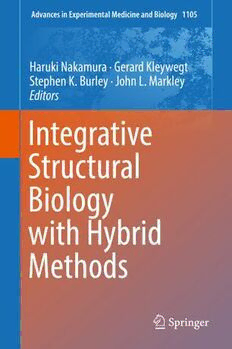
Integrative Structural Biology with Hybrid Methods PDF
Preview Integrative Structural Biology with Hybrid Methods
Advances in Experimental Medicine and Biology 1105 Haruki Nakamura · Gerard Kleywegt Stephen K. Burley · John L. Markley Editors Integrative Structural Biology with Hybrid Methods Advances in Experimental Medicine and Biology Volume 1105 EditorialBoard IRUNR.COHEN,TheWeizmannInstituteofScience,Rehovot,Israel ABELLAJTHA,N.S.KlineInstituteforPsychiatricResearch, Orangeburg,NY,USA JOHND.LAMBRIS,UniversityofPennsylvania,Philadelphia,PA,USA RODOLFOPAOLETTI,UniversityofMilan,Milan,Italy NIMAREZAEI,Children’sMedicalCenterHospital,TehranUniversityofMedical Sciences,Tehran,Iran Moreinformationaboutthisseriesathttp://www.springer.com/series/5584 Haruki Nakamura • Gerard Kleywegt Stephen K. Burley (cid:129) John L. Markley Editors Integrative Structural Biology with Hybrid Methods 123 Editors HarukiNakamura GerardKleywegt InstituteforProteinResearch EuropeanBioinformaticsInstitute OsakaUniversity Cambridgeshire,UK Suita,Osaka,Japan JohnL.Markley StephenK.Burley BiochemistryDepartment Rutgers,TheStateUniversity UniversityofWisconsin-Madison ofNewJersey Madison,WI,USA Piscataway, NJ,USA ISSN0065-2598 ISSN2214-8019 (electronic) AdvancesinExperimentalMedicineandBiology ISBN978-981-13-2199-3 ISBN978-981-13-2200-6 (eBook) https://doi.org/10.1007/978-981-13-2200-6 LibraryofCongressControlNumber:2018962157 ©SpringerNatureSingaporePteLtd.2018 Thisworkissubjecttocopyright.AllrightsarereservedbythePublisher,whetherthewholeorpartof thematerialisconcerned,specificallytherightsoftranslation,reprinting,reuseofillustrations,recitation, broadcasting,reproductiononmicrofilmsorinanyotherphysicalway,andtransmissionorinformation storageandretrieval,electronicadaptation,computersoftware,orbysimilarordissimilarmethodology nowknownorhereafterdeveloped. Theuseofgeneraldescriptivenames,registerednames,trademarks,servicemarks,etc.inthispublication doesnotimply,evenintheabsenceofaspecificstatement,thatsuchnamesareexemptfromtherelevant protectivelawsandregulationsandthereforefreeforgeneraluse. Thepublisher,theauthorsandtheeditorsaresafetoassumethattheadviceandinformationinthisbook arebelievedtobetrueandaccurateatthedateofpublication.Neitherthepublishernortheauthorsor theeditorsgiveawarranty,expressorimplied,withrespecttothematerialcontainedhereinorforany errorsoromissionsthatmayhavebeenmade.Thepublisherremainsneutralwithregardtojurisdictional claimsinpublishedmapsandinstitutionalaffiliations. ThisSpringerimprintispublishedbytheregisteredcompanySpringerNatureSingaporePteLtd. The registered company address is: 152 Beach Road, #21-01/04 Gateway East, Singapore 189721, Singapore Contents PartI IntroductionandHistoricalBackground 1 Overall Introduction and Rationale, with View fromComputationalBiology.............................................. 3 HarukiNakamura 2 Integrative/Hybrid Methods Structural Biology: Role ofMacromolecularCrystallography ..................................... 11 StephenK.Burley 3 ViewfromNuclearMagneticResonanceSpectroscopy................ 19 JohnL.Markley PartII NewExperimentalToolsEnablingHybridMethods 4 ComplementaryUseofElectronCryomicroscopyandX-Ray Crystallography:StructuralStudiesofActinandActomyosin Filaments .................................................................... 25 TakashiFujiiandKeiichiNamba 5 CurrentSolutionNMRTechniquesforStructure-Function StudiesofProteinsandRNAMolecules.................................. 43 JohnL.Markley 6 ThePATag:AVersatilePeptideTaggingSystemintheEra ofIntegrativeStructuralBiology ......................................... 59 ZubenP.BrownandJunichiTakagi 7 SmallAngleScatteringandStructuralBiology:DataQuality andModelValidation ...................................................... 77 JillTrewhella 8 StructuralInvestigationofProteinsandProteinComplexes byChemicalCross-Linking/MassSpectrometry........................ 101 ChristinePiotrowskiandAndreaSinz v vi Contents 9 PredictionofStructuresandInteractionsfromGenome Information.................................................................. 123 SanzoMiyazawa 10 A Hybrid Approach for Protein Structure Determination CombiningSparseNMRwithEvolutionaryCoupling SequenceData............................................................... 153 Yuanpeng Janet Huang, Kelly P. Brock, Chris Sander, DeboraS.Marks,andGaetanoT.Montelione 11 HarnessingtheCombinedPowerofSAXSandNMR.................. 171 A.M.Gronenborn 12 2DHybridAnalysis ......................................................... 181 AtsushiMatsumotoandKenjiIwasaki PartIII NewComputationalToolsEnablingHybridMethods 13 HybridMethodsforMacromolecularModelingbyMolecular MechanicsSimulationswithExperimentalData ....................... 199 OsamuMiyashitaandFlorenceTama 14 Rigid-BodyFittingofAtomicModelson3DDensityMaps ofElectronMicroscopy .................................................... 219 TakeshiKawabata 15 Hybrid Methods for Modeling Protein Structures Using Molecular Dynamics Simulations and Small-Angle X-Ray ScatteringData ............................................................. 237 ToruEkimotoandMitsunoriIkeguchi PartIV DataValidationandArchivesforHybridMethods 16 ArchivingofIntegrativeStructuralModels............................. 261 Helen M. Berman, Jill Trewhella, Brinda Vallat, andJohnD.Westbrook Part I Introduction and Historical Background Chapter 1 Overall Introduction and Rationale, with View from Computational Biology HarukiNakamura Abstract By integrating the experimental information given from the Hybrid/ Integrativemethodstodeterminethestructuresoflargemacromolecularmachines, the static and dynamic molecular models in the atomic or semi-atomic resolution have been built with the aid of bioinformatics and computer simulations. Here, review of the recent progresses of such computational methods are made with discussionforthefuturedirection. Keywords Hybrid/integrativemethods · Computationalbiology · Structural biology · X-ray · SAXS · NMR · Cryo-EM 1.1 Introduction Inrecentyears,thestructuresoflargemacromolecularmachinesincellshavebeen determinedbycombiningobservationsfrommultiple,complementaryexperimental methods, such as X-ray crystallography, NMR spectroscopy, 3DEM (three- dimensional Electron Microscopy), X-ray and Neutron small-angle scattering (SAXS and SANS), FRET (Förster Resonance Energy Transfer), chemical crosslinking, and many others. In addition, by integrating such experimental information,thestaticanddynamicmolecularmodelsintheatomicorsemi-atomic resolutionhavebeenbuiltwiththeaidofbioinformaticsandcomputersimulations. Currently, many structures determined by those so-called hybrid methods appear in high-impact-factor journals, and their atomic models are being deposited in the PDB (Protein Data Bank) (Berman et al. 2013, 2016) and the pilot site for the hybridmethods,PDB-dev(https://pdb-dev.wwpdb.org/)(Burleyetal.2017)which ismanagedbyaninternationalorganization,thewwPDB(worldwidePDB:https:// wwpdb.org/)(Bermanetal.2003,2007;Markleyetal.2008) H.Nakamura((cid:2)) PDBj,InstituteforProteinResearch,OsakaUniversity,Suita,Osaka,Japan e-mail:[email protected] ©SpringerNatureSingaporePteLtd.2018 3 H.Nakamuraetal.(eds.),IntegrativeStructuralBiologywithHybridMethods, AdvancesinExperimentalMedicineandBiology1105, https://doi.org/10.1007/978-981-13-2200-6_1 4 H.Nakamura InOctober2014,ataskforcewwPDBworkshopwasheldtodiscusshowstruc- tural models derived from the integration of hybrid methods should represented, validatedandarchived.NewsaboutthisworkshopwaspublishedinNature(Ewen 2014),andtheproceedingsoftheworkshopwerepublishedinStructure(Salietal. 2015).OnOctober3,2015,thewwPDBSymposium“IntegrativeStructuralBiology withHybridMethods”washeldinOsaka,Japan. This book will present the methods used to determine, validate, and archive structural models of large biomolecular complexes and cellular machines. Recent examples will be discussed along with current trends in molecular and cellular structural biology. Most of the initially proposed authors were speakers at the wwPDB symposium on October 3, 2015, and the book was first planned to serve asanupdatedsummaryofthatmeeting.However,theprogressinthisfieldhasbeen muchfasterthanwhatweplannedfirst,andsoweextendedtheChapterscovering the latest developments, which, we are sure, should be useful as one of the book series,AdvancesinExperimentalMedicineandBiology. Here,wereviewtherecentprogressesofsuchcomputationalmethodsforseveral roles in the Hybrid/Integrative methods: (i) Analysis of genome information to obtainstructuralinformationatvariouslevels,(ii)Integrationofvariousmethodsto buildthemostprobableatomicorsemi-atomicresolutionmodels,and(iii)Analysis ofdynamicnaturesofcomplexstructures.Finally,wediscussthefuturedirectionof theHybrid/Integrativemethodswiththeaidofthecomputationalbiology.Thereare otherimportantissues,ValidationofstructureswiththeHybrid/Integrativemethods and Archiving of structural models determined by Hybrid/Integrative methods. Thosewillbedescribedbyotherauthorsinthisbook,andwewillnottouchthese issueshere. 1.2 AnalysisofGenomeInformationtoObtain Structural Information There has been a long history to predict 3D protein structures from genome information, including comparative or homology modeling for the homologous proteinswithsequencesimilaritieslargerthan30%,anddenovostructuralmodeling with sequence similarities less than 30% to any known structures. Many methods have been developed and been matured during the blind contests, the Critical Assessment of Techniques for Protein Structure Prediction (CASP), since 1994 (Moult et al. 2016). Another blind contest, the Critical Assessment of Predicted Interactions (CAPRI), has also been established as the community-wide initiative since 2001, in order to develop reliable methodologies to predict protein-protein interactionsandstructuresofproteinassemblies(WodakandJanin2017). In particular, by distinguishing true co-evolution couplings from the noisy observationfortheevolutionarysequencevariation,accuratepredictionsofresidue- residue contacts have been made, and more reliable 3D protein structures are
